This post may contain affiliate links. For more information, please see our affiliate policy.
Learn How to Blanch Broccoli to tame its raw, bitter taste. Then you can sauté it for stir-fries, add it to pasta salads, or pile it on your next vegetable platter.
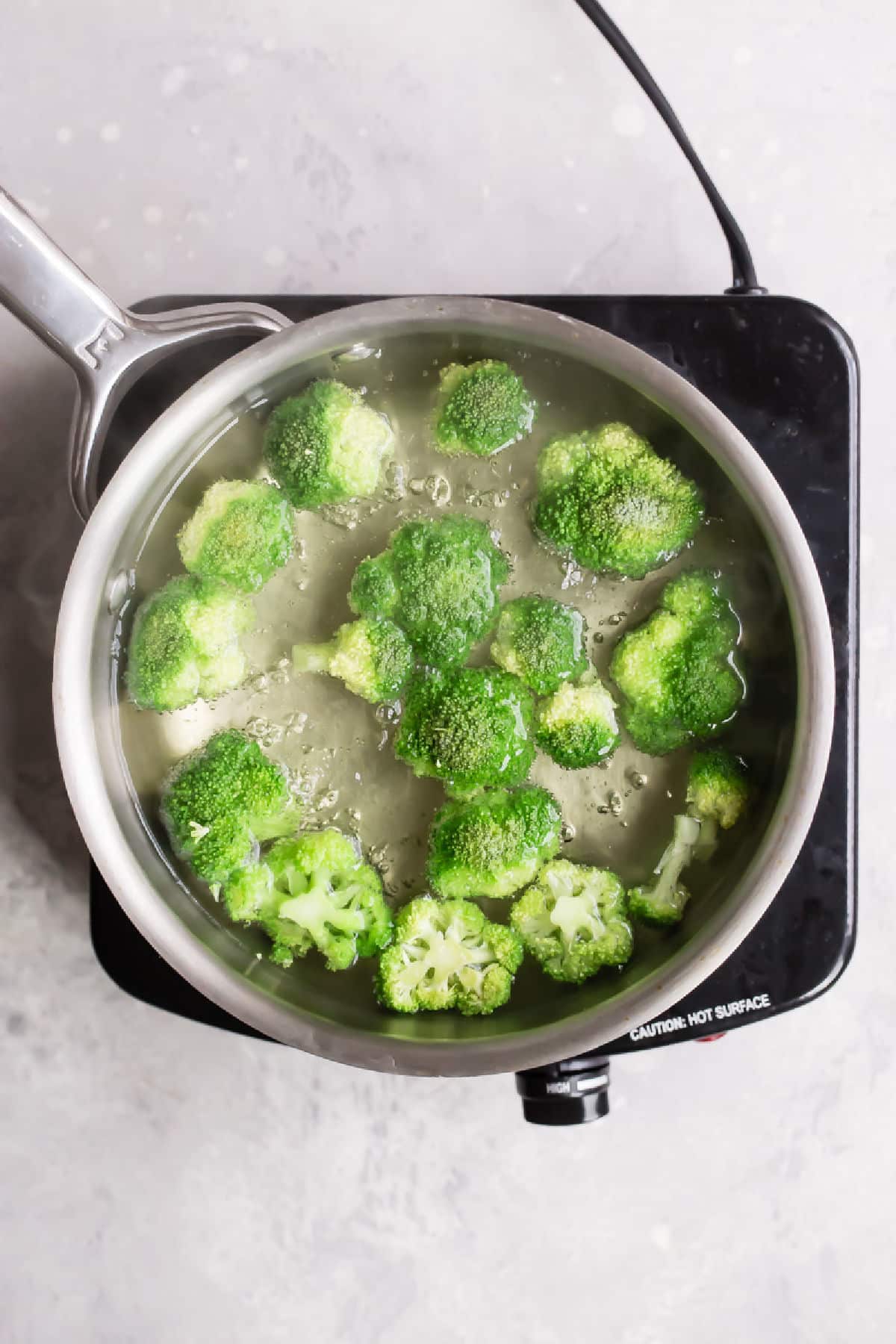
Blanched broccoli is an easy, healthy ace to keep up your sleeve. Blanching is a cooking process that removes the harsh, bitter taste of raw broccoli while setting its bright green color. You start by boiling raw broccoli florets for just a few minutes, then plunging the florets into an ice bath. By doing these two steps quickly, you’ll get a tender-crisp texture and a nice, mellow flavor.
I like to blanch broccoli before adding it to Vegetable Platters, pasta salads, Brown Fried Rice, stews, and other dishes. It’s also a fantastic component of any meal prep plan.
Table of Contents
Tutorial notes
- Uniform size: Cut the broccoli florets into pieces that are all about the same size so they cook evenly.
- Buying: Choose bright green broccoli that has a firm stalk without yellowing florets or brown spots. Broccoli should feel heavy for its size.
- Storing: Whole broccoli should be stored in an open bag in the refrigerator. Use broccoli within 3-4 days.
Step-by-step instructions
- Bring a large pot of water with salt to boil and fill a large bowl with cold water and ice. Lower the broccoli florets into the boiling water and cook for 2 to 3 minutes. The broccoli should be bright green and tender-crisp.
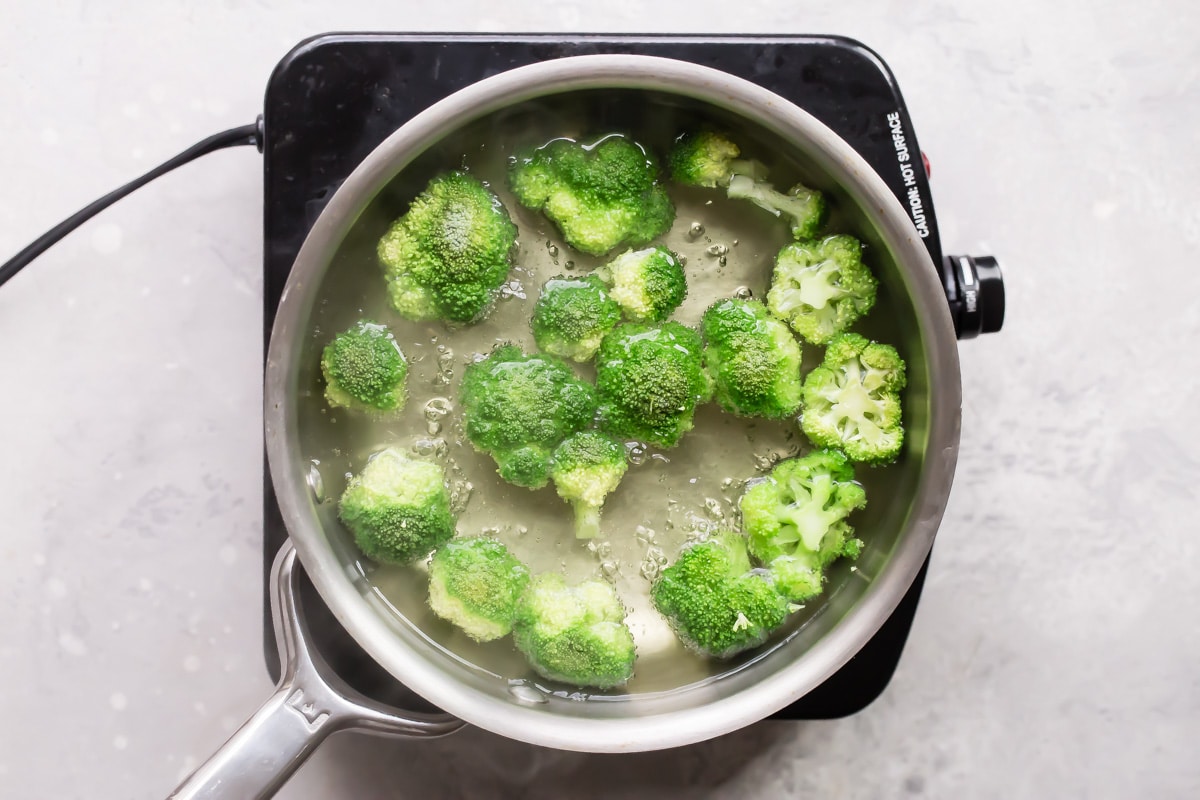
- Remove the broccoli and immediately plunge into the bowl of ice water. When the broccoli is completely cool, drain well.
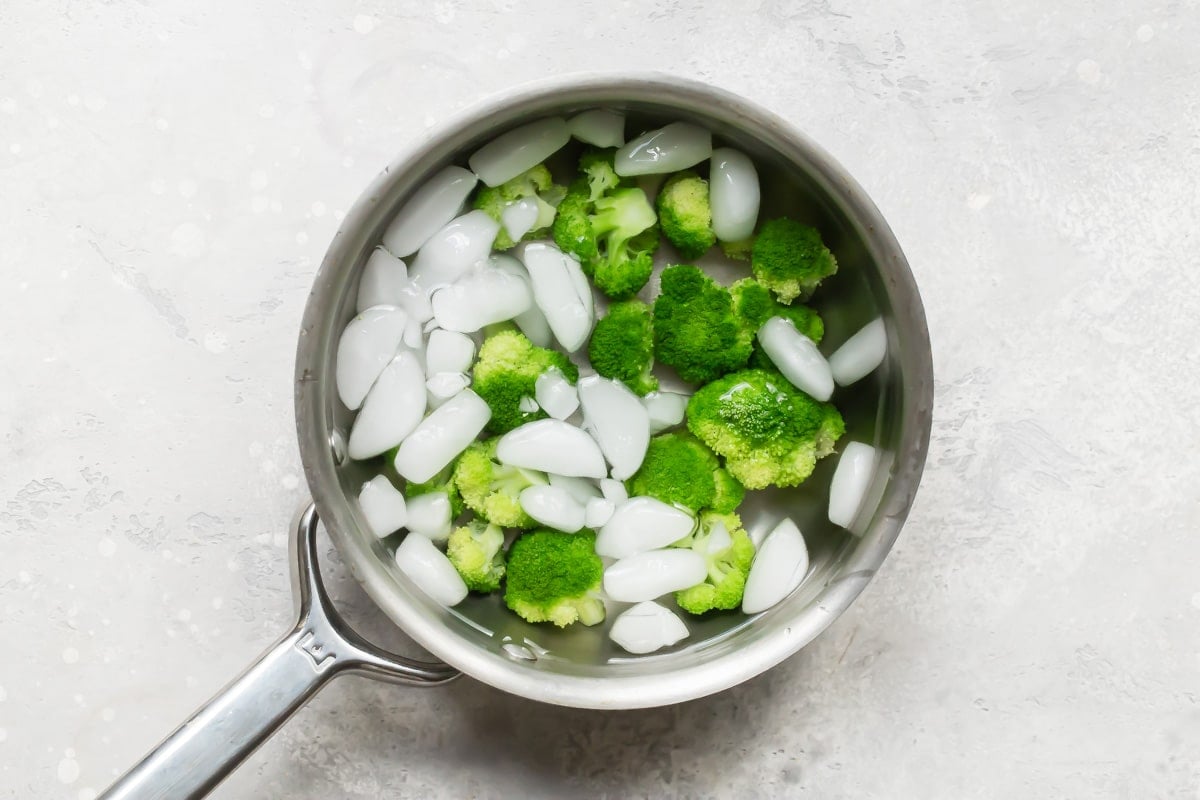
Recipe tips and variations
- Yield: This recipe makes 6 servings (½ cup blanched broccoli each). 1 pound of broccoli yields about 6 cups of raw florets or 3 cups of blanched florets.
- Storage: Store leftovers covered in the fridge for up to 4 days.
- Freezer: Arrange drained broccoli in a single layer on a baking sheet pan lined with parchment or waxed paper and put it in the freezer (this is flash freezing). Once the broccoli is frozen, transfer it to a freezer bag. Label, date, and freeze broccoli up to 9 months. Remove and reheat any portion size, or thaw the whole bag overnight in the refrigerator before reheating.
- Just the stems: If you have a recipe that makes use of the florets, you could cut up, blanch, and freeze just the sturdy broccoli stems. Waste not!
- Sauce it up: Blanched broccoli makes a delicious side dish with a drizzle of hollandaise, teriyaki sauce, or cheese sauce.
- Leftovers: Use leftover blanched broccoli in an Omelet or Scrambled Eggs, Seafood Pasta Salad, or green salad.
- More vegetables to cook: Try blanching green beans and blanching asparagus. Carrots, cauliflower, and other sturdy vegetables work well too. Roasted Broccoli is another favorite and you can do it with just a drizzle of olive oil and some salt.
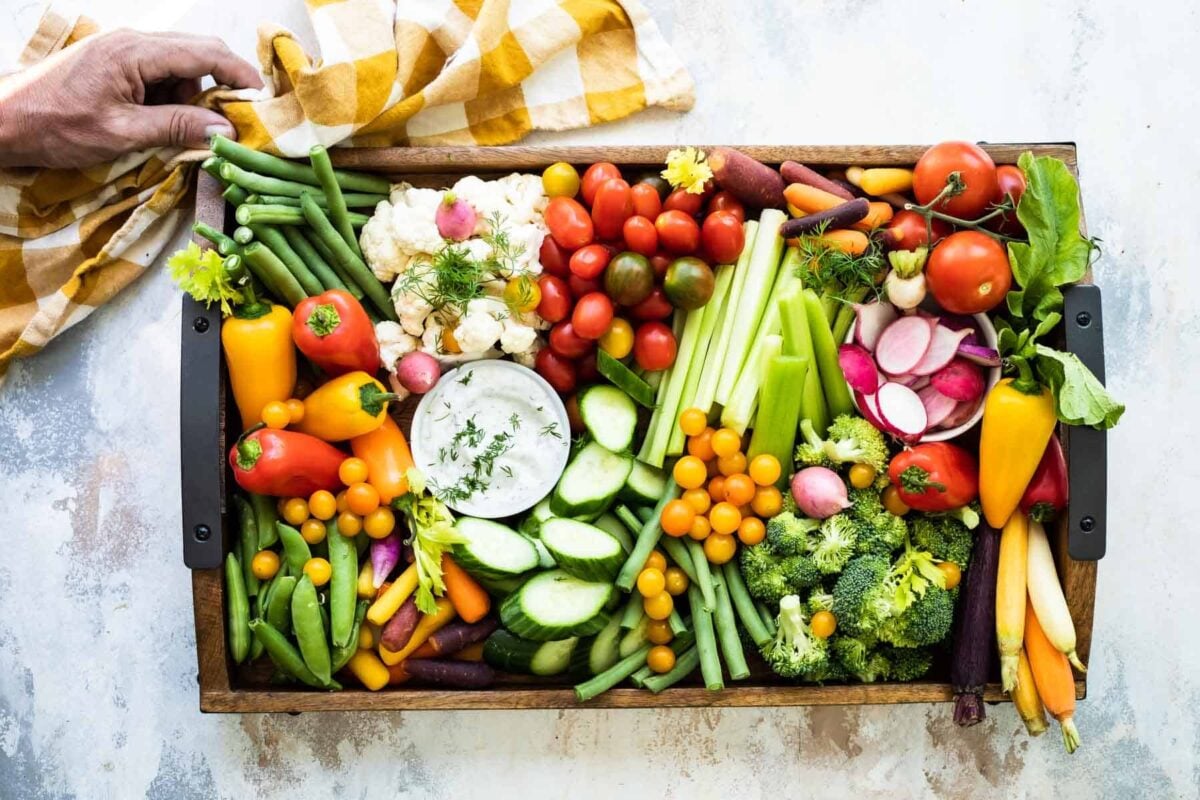
Frequently Asked Questions
The easiest way to blanch broccoli is to drop it in a large pot of salted boiling water. Leave it for just a couple of minutes, then pull it out and plunge it into an ice bath until cool.
Blanching is a cooking process that removes the harsh, bitter taste of raw broccoli while setting its bright green color. It also ensures that the broccoli won’t be overcooked as it can just be tossed with a finished recipe at the end.
If your water is already boiling, it takes about 2 to 3 minutes to blanch it in boiling water, and then another 2-3 minutes to cool it down in an ice bath. Plan on 5 to 10 minutes total depending on whether you are starting with broccoli florets or need to cut them up yourself.
Best broccoli recipes
Salad Recipes
Broccoli Salad with Bacon and Cheese
Vegetable Recipes
Roasted Broccoli
Salad Recipes
Easy Cold Pasta Salad
Casserole Recipes
Vegetable Casserole
Join Us
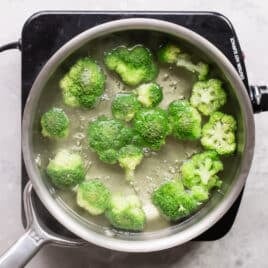
How to Blanch Broccoli
Ingredients
- 2 pounds broccoli florets
- 2 teaspoons Salt (optional)
Instructions
- Bring 4 quarts water and 2 teaspoons salt to a rapid boil. Fill a large bowl with cold water and ice.
- Carefully lower the broccoli florets into the boiling water and cook for 2 to 3 minutes. The broccoli should be bright green and just barely tender.
- With a slotted spoon, remove the broccoli and immediately plunge into the ice water.
- When the broccoli is completely cool, drain it from the ice water and pat dry with a paper towel.
Recipe Video
Notes
- Uniform size: Cut the broccoli florets into pieces that are all about the same size so they cook evenly.
- Buying: Choose bright green broccoli that has a firm stalk without yellowing florets or brown spots. Broccoli should feel heavy for its size.
- Storing: Whole broccoli should be stored in an open bag in the refrigerator. Use broccoli within 3-4 days.
- Yield: This recipe makes 6 servings (½ cup blanched broccoli each). 1 pound broccoli yields about 6 cups raw florets or 3 cups blanched florets.
- Storage: Store leftovers covered in the refrigerator for up to 4 days.
Nutrition
Meggan Hill is a classically-trained chef and professional writer. Her meticulously-tested recipes and detailed tutorials bring confidence and success to home cooks everywhere. Meggan has been featured on NPR, HuffPost, FoxNews, LA Times, and more.

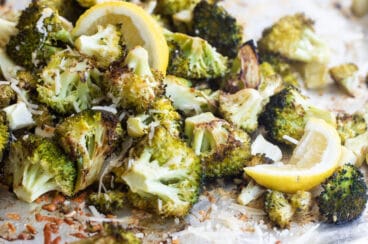
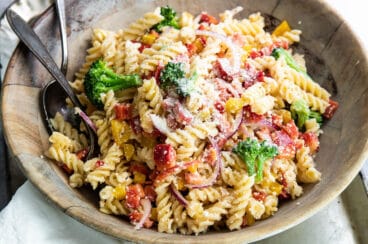

Blanching broccoli is a simple yet powerful technique that can elevate your culinary creations. Whether you’re aiming for a vibrant side dish or a nutritious addition to your favorite recipes,.
🙂👍
Thank you for this! I am new to the fresh food ideal and I went a little crazy at the farmer’s market. I didn’t want to waste anything and this was the perfect thing to keep my produce from going bad!
Happy to help Leticia, hope you enjoy all your farmer’s market goodies! – Meggan
Isn;t that what Meggan just said!!
Once the broccoli has drained, put it in one layer on a sheet pan lined with a piece of waxed paper and put it in the freezer. Once the florets are frozen, put them in a ziploc bag and only take out as much as you need at the time. Works great for me because I am the only one in my house who eats broccoli.
When you place the food in the boiling water, the water cools. Are you saying that the water MUST return to a boil, then count the cooking time, or is it just total time in the water?
Hi Bob, it will be for 2 to 3 minutes of time boiling in the water, so once the water’s heat recovers. It may vary in time depending on the size of the florets, so you will want to look for the broccoli to turn bright green and start to become tender. Thank you! – meggan
Why is so much salt needed? 1237 mg seems like a very, very dangerous and high amount
Hey there, sorry about that! It’s just a mistake with the nutrition label. We accidentally included the salt for the water as an ingredient. Salting the water is OPTIONAL and if you leave it out, the sodium is negligible. I do personally still salt the water for blanching but that’s just my preference, and its not the same as just eating a tablespoon of salt. -Meggan
thank you for the easy process. i use this recipe to sub fresh brocc when a recipe calls for frozen.